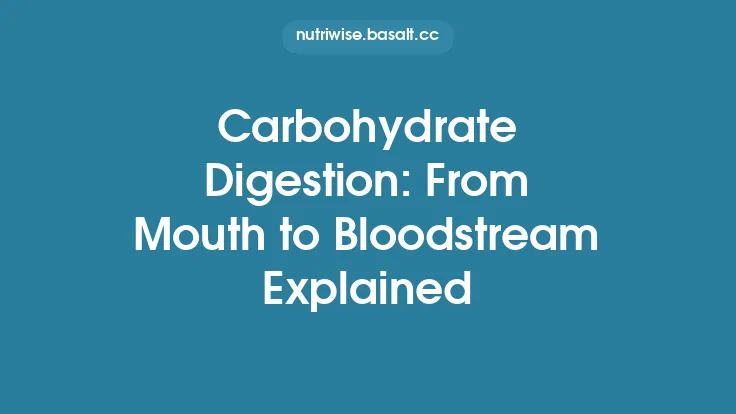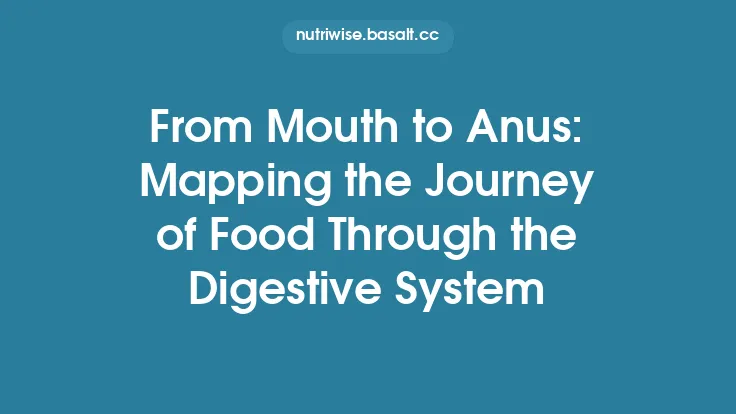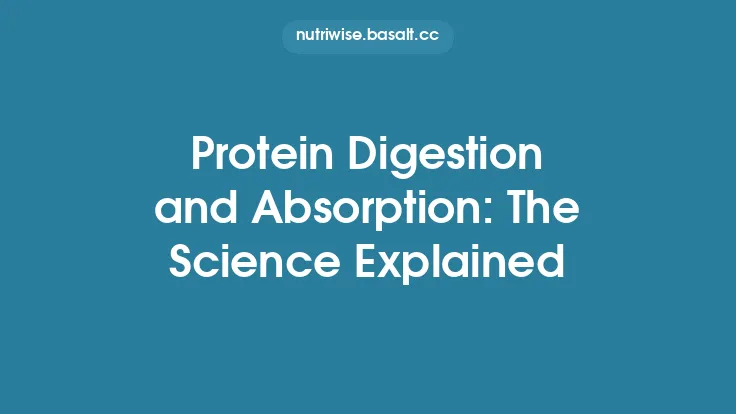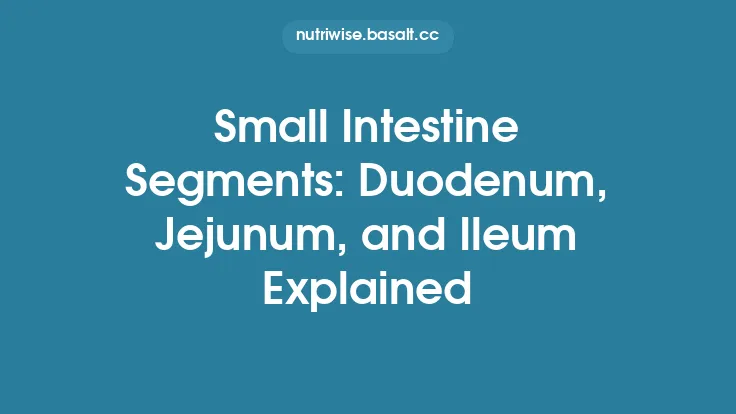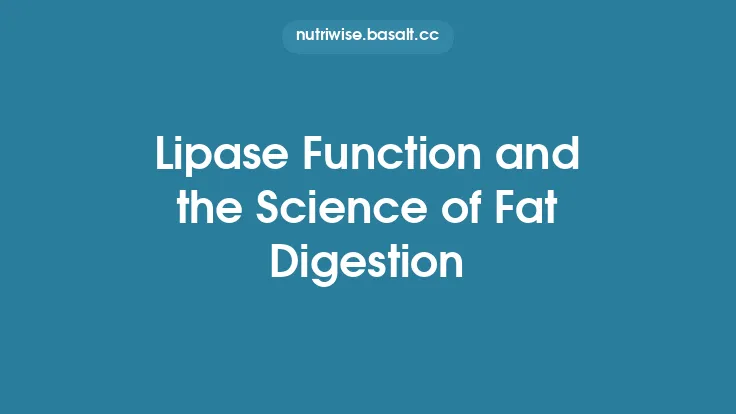Carbohydrates enter the digestive tract as complex polymers—primarily starches and glycogen—that are too large to be absorbed directly through the intestinal epithelium. The body therefore relies on a cascade of enzymatic reactions to cleave these polymers into monosaccharides, chiefly glucose, which can be transported into the bloodstream. The enzyme that initiates this cascade is amylase, a glycoside hydrolase that begins its work in the oral cavity and resumes activity in the small intestine. Understanding how amylase functions, where it is produced, and how it interacts with dietary carbohydrates provides a clear picture of the first critical steps in nutrient acquisition.
Salivary Amylase: The First Line of Defense
Salivary amylase, also known as ptyalin, is secreted by the serous acini of the parotid, submandibular, and sublingual glands. Its secretion is stimulated by both cephalic phase reflexes (sight, smell, and thought of food) and the mechanical act of chewing, which activates parasympathetic pathways via the facial and glossopharyngeal nerves. The enzyme is released into the oral cavity in a watery saliva matrix that contains electrolytes, mucins, and other proteins that help lubricate food and maintain a moist environment conducive to enzymatic activity.
The primary substrates for salivary amylase are the α‑1,4‑glycosidic linkages found in amylose (the linear component of starch) and the outer chains of amylopectin (the branched component). By hydrolyzing these bonds, ptyalin produces a mixture of maltose, maltotriose, and α‑limit dextrins—shorter branched oligosaccharides that retain some α‑1,6 linkages. Although the enzyme cannot cleave the α‑1,6 bonds directly, the generation of these smaller fragments dramatically increases the surface area available for subsequent enzymatic attacks downstream in the digestive tract.
Molecular Mechanism of Starch Hydrolysis
Amylases belong to the glycoside hydrolase family 13 (GH13) and share a conserved (β/α)_8‑barrel catalytic domain. The active site houses two essential acidic residues: a catalytic aspartate that acts as a nucleophile and a glutamate that serves as a general acid/base. The reaction proceeds via a double‑displacement (retaining) mechanism:
- Glycosylation Step – The aspartate attacks the anomeric carbon of the α‑1,4‑glycosidic bond, forming a covalent glycosyl‑enzyme intermediate while the glutamate donates a proton to the leaving oxygen, releasing the aglycone portion of the substrate.
- Deglycosylation Step – A water molecule, activated by the glutamate acting now as a base, attacks the intermediate, regenerating the free enzyme and releasing a maltose or maltotriose unit.
The enzyme’s substrate‑binding cleft contains several subsites (−4 to +4) that accommodate consecutive glucose residues. Proper alignment of the substrate within these subsites ensures that the scissile bond is positioned precisely over the catalytic residues, dictating the enzyme’s specificity for α‑1,4 linkages. Structural studies using X‑ray crystallography have revealed that subtle variations in the loops surrounding the active site modulate the affinity for different starch granule morphologies, explaining why some starches (e.g., high‑amylose varieties) are hydrolyzed more slowly than others.
Transition from Oral to Gastric Phase
Chewing reduces food particles to a bolus with a surface area that maximizes contact with salivary amylase. As the bolus is swallowed, it enters the acidic environment of the stomach (pH ≈ 2). Salivary amylase exhibits optimal activity near neutral pH; the low gastric pH rapidly diminishes its catalytic efficiency, effectively halting carbohydrate hydrolysis until the chyme is neutralized in the duodenum. Nevertheless, the products generated in the mouth—maltose, maltotriose, and limit dextrins—remain intact through the gastric phase, providing a ready pool of substrates for the next enzymatic wave.
Pancreatic Amylase: Continuing the Breakdown
Once the partially digested chyme reaches the duodenum, the pancreas secretes pancreatic α‑amylase (also a GH13 enzyme) into the lumen via the pancreatic duct. Pancreatic amylase differs from its salivary counterpart in several respects:
- Higher Specific Activity – It operates at a faster turnover rate, reflecting the need to process larger quantities of carbohydrate in the small intestine.
- Broader Substrate Range – While still targeting α‑1,4 bonds, pancreatic amylase can accommodate longer oligosaccharides and partially hydrolyzed limit dextrins more efficiently.
- Resistance to Inhibition – The enzyme is less susceptible to feedback inhibition by its own products, allowing sustained activity throughout the intestinal transit.
Pancreatic amylase works in concert with brush‑border enzymes—maltase, isomaltase, and sucrase‑isomaltase—that are embedded in the microvilli of enterocytes. These membrane‑bound enzymes cleave the disaccharides and short oligosaccharides produced by amylase into absorbable monosaccharides. For example, maltase hydrolyzes maltose into two glucose molecules, while isomaltase targets α‑1,6 linkages in limit dextrins, completing the breakdown of branched starch fragments.
Integration with Other Carbohydrate‑Digesting Enzymes
Although amylase initiates the degradation of polysaccharides, the overall efficiency of carbohydrate digestion depends on a coordinated network of enzymes:
- Brush‑Border Disaccharidases – Located at the apical surface of the small‑intestinal epithelium, these enzymes finalize the conversion of oligosaccharides into glucose, galactose, and fructose.
- Sucrase‑Isomaltase Complex – A bifunctional protein that hydrolyzes both sucrose (via its sucrase activity) and α‑1,6 linkages (via its isomaltase activity), ensuring that all residual branched fragments are resolved.
- Transporters – Sodium‑glucose linked transporters (SGLT1) and facilitative glucose transporters (GLUT2) then move the monosaccharides across the enterocyte membrane into the portal circulation.
The seamless handoff from amylase to brush‑border enzymes exemplifies the compartmentalized yet interdependent nature of digestive biochemistry. Any disruption in this sequence—whether due to enzyme deficiency, genetic mutation, or pathological obstruction—can lead to malabsorption syndromes characterized by carbohydrate intolerance and osmotic diarrhea.
Physiological Significance and Clinical Considerations
The rapid initiation of carbohydrate digestion by amylase has several physiological advantages:
- Energy Availability – By beginning carbohydrate breakdown in the mouth, the body can deliver glucose to the bloodstream shortly after a meal, supporting postprandial energy demands.
- Gastric Emptying Regulation – The presence of glucose and maltose in the duodenum triggers hormonal feedback (e.g., incretin release) that modulates gastric motility and insulin secretion.
- Oral Health – Salivary amylase reduces the viscosity of starchy foods, facilitating mastication and minimizing the risk of food particles adhering to teeth surfaces.
Clinically, measurement of amylase activity in serum is a routine diagnostic tool for pancreatic disorders, but it also reflects salivary gland function. Conditions such as xerostomia (dry mouth) can diminish salivary amylase output, leading to impaired oral starch digestion and altered taste perception. Conversely, hyperamylasemia may indicate pancreatic inflammation or obstruction, underscoring the enzyme’s dual relevance in both digestive and systemic health.
Future Directions in Amylase Research
Advances in molecular biology and protein engineering are opening new avenues for exploring amylase function:
- Genomic Variability – Population‑scale sequencing has identified polymorphisms in the AMY1 (salivary) and AMY2 (pancreatic) genes that correlate with dietary starch intake, suggesting an evolutionary adaptation to carbohydrate‑rich diets.
- Enzyme Engineering – Directed evolution techniques are being applied to create amylase variants with enhanced stability at extreme pH or temperature, which could improve industrial processes such as starch liquefaction.
- Microbiome Interactions – Emerging evidence indicates that oral and gut microbiota can modulate host amylase activity, either by producing amylase‑like enzymes themselves or by influencing host gene expression.
These research fronts promise to deepen our understanding of how amylase not only initiates carbohydrate digestion but also integrates with broader metabolic and ecological systems.
In sum, amylase serves as the gateway enzyme that transforms complex dietary carbohydrates into absorbable sugars. Beginning its work in the mouth with salivary amylase and continuing in the small intestine with pancreatic amylase, it orchestrates a finely tuned sequence of hydrolytic events that are essential for efficient nutrient acquisition and overall metabolic health.
